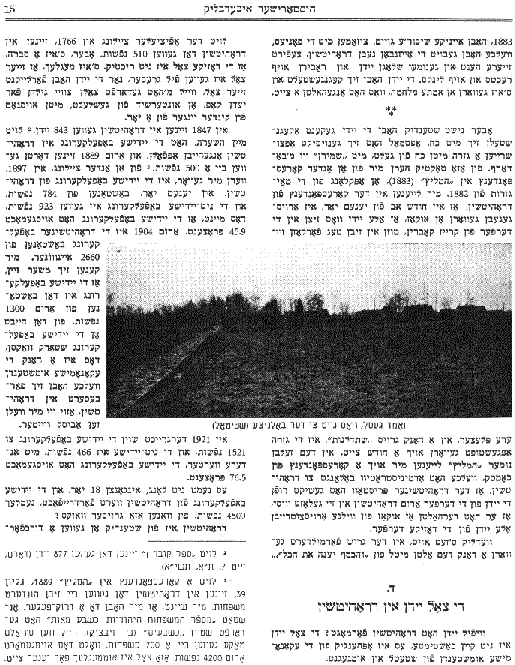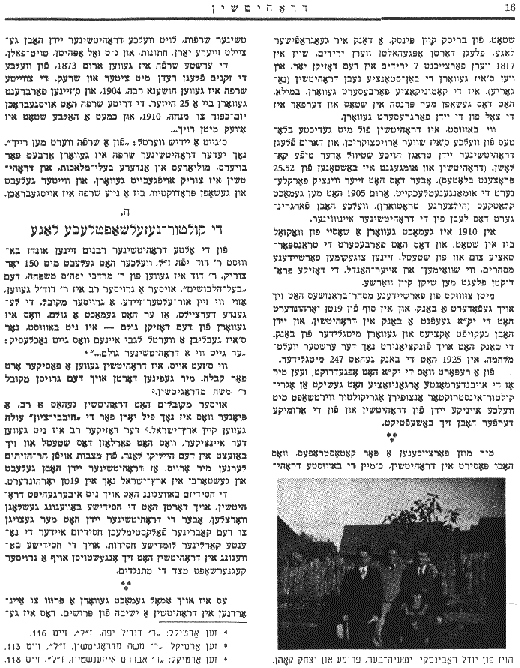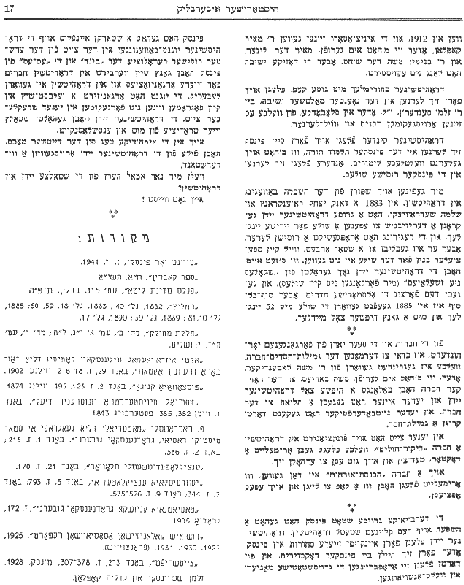Previous Page
|
Next Page
 [
Page 15
]
[
Page 15
]
some drunken gentiles, together with some Russians who built the railroad near
Drohitchin, started beating Jews, and looting everywhere. The Jews defended
themselves, and the conflict turned into a real war that lasted for quite a
while.
**
*
The Jews were not always successful in defending themselves with force. It was
often necessary to pay or bribe someone in order to get a decree rescinded.
Another letter in
Hamlitz
(1883) describes such a tactic, which took place during a repeat of the May
Decrees of 1882. The letter from Drohitchin stated that in the month of Av
[August] of that year, a decree was issued ordering all the Jews living in the
villages in the Kobrin region to leave their homes within seven days. Thanks to
an "intercession" of a large sum of money, the decree was delayed for
a month. In the same issue of
Hamelitz,
there appeared a letter from someone in Khomsk, a village administered by
Drohitchin at that time, whp wrote that the Commissioner of Police of
Drohitchin assembled all the Jews of the villages surrounding Drohitchin, and
informed them that he had received a decree from Vilna ordering the expulsion
of all the Jews from their villages.
It appears, however, that the decree was never put into effect thanks to the
implementation of the age-old adage, "money talks."
[photo caption:] Sand alley leading to the hospital.
D.
THE NUMBER OF JEWS IN DROHITCHIN
How many Jews were there in Drohitchin? The number of Jews is not precise, and
depends on the economic conditions of the town and the surrounding areas.
According to the official census of 1766, there were 510 Jews in Drohitchin.
But there is reason to believe that this number is probably incorrect. It is
possible that there were many more Jews, but that the Jews lied about their
numbers because they had to pay a head tax of two gilders, regardless of sex.
The only exception was for children under a year old.
In 1847 there were 843 Jews in Drohitchin. According to my estimate, the
Jewish population in Drohitchin began to decline, and around 1889 there were
only approximately 500 souls. Another census, in 1897, indicates that at that
time the Jewish population of Drohitchin was 784, and the non-Jewish population
923, meaning that the Jewish population was 45.9 percent. Around 1904, the
population of Drohitchin was 2660 inhabitants. We can conjecture that the
Jewish population then consisted of around 1300 people. Thereafter, the Jewish
population started to increase significantly, thanks to the increasingly
favorable economic conditions in Drohitchin, a subject we will address later
on.
In 1921, the Jewish population reached 1521, and the non-Jewish population 466.
In other words, the Jewish population was 76.5 percent.
The Jewish population increased threefold, to 4500, in only 18 years. How did
this great increase come about?
 [
Page 16
]
[
Page 16
]
Drohitchin was on the road that
ran from Brisk [
Brest-Litovsk
] to Pinsk. Because of its geographic location, fairs or markets were
frequently held in Drohitchin. Even in 1817, there were 7 fairs there. When the
train station was built near Drohitchin (in Nagoria), transportation became
even better. This, in turn, led to more economic opportunities in the town, and
therefore to the growth in the number of Jews.
As is well known, Drohitchin had many deep marshlands that were difficult to
get through, and therefore the local Jews used to wear high boots or galoshes
(25.52 percent of Drohitchin and the surrounding area consisted of marshlands).
Wearing boots, however, did not reduce the unpleasantness very much. Wooden
sidewalks, built around 1905, did improve the lives of the inhabitants of
Drohitchin.
In 1910 a road was built from the train station to the city. This improved
transportation to and from town. This development gave rise to a lot of new
business activity to town, such as mushrooms and egg businesses that shipped
their products to Warsaw.
As the economy grew, a bank became necessary; at the end of the nineteenth
century ICO opened a bank in Drohitchin. Jews bought stock and became investors
in the bank. The bank continued to operate even after the First World War. In
1925, the bank had 247 investors.
An ICO report showed, we see that the aforementioned institution sent an
agriculture instructor to teach farming to a few Jews from Drohitchin and
surrounding villages who he employed.
**
*
[photo caption:] House of Yudel Ravinsky, Yeshayahu-Ber, Fruma and Yitzchak
Kahn.
We should note a few catastrophes that occurred in Drohitchin, specifically the
famous Drohitchin fires, based on which Drohitchin Jews dated their ages,
marriages and their deaths.
The first big fire occurred around 1873, and about which the elderly spoke of
with trembling and fear. The second fire took place on Hoshana Rabba [the
seventh day of the holiday of Sukkot – Friday Sept. 30] in 1904, and which
burned to the ground approximately 25 homes. The third fire broke out in 1910
on Yom Kippur afternoon, and practically half the town went up in smoke.
There is a Yiddish proverb: "A fire will make you rich." Each fire in
Drohitchin provided work for builders, painters and other artisans. Drohitchin
was rebuilt, and life continued productively until the next fire broke out.
E.
CULTURAL AND SOCIAL CONDITIONS
Of the rabbis who had lived in Drohitchin, we were most familiar with Reb Dovid
Yaffe, of blessed memory, who lived 150 years ago. Reb Dovid was of the family
of Reb Mordechai Yaffe, the author of the famous rabbinical work,
Levushim [Garments]
. In addition to being a great rabbi, Reb Dovid was also a great kabbalist.
Legend has it that he created a golem, though no one knows the fate of this
golem. There is a folk expression, however, about the golem, in reference to an
idle person: "He walks around like a Drohitchiner golem." It seems
that Drohitchin was a hospitable place for the study of Kabbalah. The great
kabbalist, Reb Moshe of Drogitchin also lived there.
In addition to kabbalists, Drohitchin also had a community rabbi, a pioneer,
who moved to the Holy Land years before the advent of the Lovers of Zion
movement. That rabbi, however, was not the only one who left town and settled
there. Inscriptions on tombstones on the Mount of Olives in Jerusalem show that
other Drohitchin Jews lived and died in Palestine as early as the 19th century.
The chassidic movement did not bypass Drohitchin. The chassidic movement put
down roots there too, but the people of Drohitchin were more attracted to the
more folksy chassidism of Kobrin than the more scholarly chassidism of the
closer town, Karlin. The chassidism of Drohitchin also encountered greater
opposition from the opponents of chassidism [called
Mitnagdim
].
**
*
There was once also an attempt to establish a yeshiva in Drohitchin for
full-time Torah scholars.
 [
Page 17
]
[
Page 17
]
This was in 1912, and the idea was initiated Reb Meir Kaplan (also known as
Meir the Borrower), and Reb Benyomin Moshe, the Ritual Slaughterer. This
yeshiva did not last very long, however.
Bright young men in Drohitchin would also travel to the nearby Maltch Yeshiva
to learn with Reb Zalman Sender, or to the Slobodka Yeshiva, which produced
rabbis and scholars.
The children of Drohitchin would also attend the Talmud Torah [religious
elementary school] of Pinsk, where secular studies were also included in the
curriculum. Others studied at the Russian schools in Pinsk.
Traces of the Enlightenment also found their place in Drohitchin. In 1883,
through the efforts of Yitskhak Rosenkrantz and Shlomo Shedrovitsky, a group of
Drohitchin Jews were granted permission to open a school for Jewish boys, and
the government sent them a Russian teacher. The teacher didn't have a stitch of
work to do because there was no special building to house the school. It seems
that the majority of Jews in Drohitchin were still not interested in such
school was necessary, giving priority, instead, to the old-fashioned cheders
[traditional religious primary schools]. Finally, in 1885, a school was opened
with 52 boys and quite a large number of girls.
**
*
Of the various community organizations that existed in the 1890s, we should
note the Free Loan Society, founded by Reb Moshe Lobendiker, or as he was
called, Moshe Badya's [referring to his mother first name]. A large number of
Drohitchin Jews belonged to that organization, and each one lent money to the
society so that any person in need could obtain an interest-free loan.
Another society also functioned in Drohitchin in those day was the Care for the
Infirm Society [called
Bikkur Kholim
in Orthodox Jewish communities], which would provide the poor with doctors,
medicine and nutritious food to eat to help them recover.
The Guest Society [Hakhnasat Orkhim] was another organization; it provided
housing and food for the poor.
**
*
The nearby large city of Pinsk had an influence on the little town of
Drohitchin. The Jews of Drohitchin used to travel to Pinsk to buy their
merchandise or to visit doctors; they used to bring back big-city manners and
secular ideas from Pinsk.
Pinsk had a strong influence on the youth movement in Drohitchin at the time of
the first Russian revolution. The Bund and the S.S. of Pinsk were very
successful in recruiting members for their organizations in Drohitchin, and
there was much excitement in Drohitchin during that time. The youth of
Drohitchin organized a vigilante group, and there were no pogroms during those
terrible times. The Drohitchin Jews proudly defended their tradition of courage
and determination.
Even during the terrible days of German occupation, many Jews of Drohitchin
displayed acts of resistance.
Will we ever again hear about the proud Jews of Drohitchin?
Only G-d knows!
**
*
SOURCES
A Thousand Years in Pinsk
, N.Y., 1941.
The Book of Kobrin
, Tel-Aviv, 1981.
Registry Book of the State of Lithuania
, p. 115, Berlin, 1921.
[Hebrew:] Hamelitz
,
1882, vol.40; 1883, vols. 18, 59, 60; 1885, vols. 10, 81; 1889, vol. 39; 1890,
vol. 17.
[Hebrew:] The Portion of the Law Giver
vol. 2, pp. 1, 13, 35; vol. 4, p. 44, Jerusalem.
"[Russian:] Documents Issued by the Vilna Commission for the Collection of
Old Documents" Vol. 29, pp. 216-218 Vilna, 1902.
[Russian:]
Property Registry,
Vol. 2, pp. 123, 495, Vilna 1874.
Journal of the Ministry of Internal Affairs
,
Vol. 1, pp. 382, 385, Petersburg 1843.
Bobrovsky, "[Russian:] Material for the Geography and Statistics of
Russia, Grodno Gubernia" Vol. 1, p. 215; Vol. 2, p. 386.
"[Russian:] Encyclopedic Dictionary," Vol. 21, p. 170.
"[Russian:] Jewish Encyclopedia," Vol. 5, p. 793; Vol. 7, p. 344;
Vol. 9, pp. 575-576.
"[Russian:]
Memorial Book of the Gubernia of Grodno,
" p. 172, Grodno 1905.
"Jewish Colonization Association Report," 1925, 1927, 1930, 1931,
(French).
"Zeitschrift" ["Periodical"] Vol. 2-3, pp. 307-378, Minsk,
1928, Zalman Shevinsky and Gedaliah Kaplan.
Previous Page
|
Next Page
This material is made available by JewishGen, Inc.
and the Yizkor Book Project for the purpose of
fulfilling our
mission of disseminating information about the Holocaust and
destroyed Jewish communities.
This material may not be copied,
sold or bartered without JewishGen, Inc.'s permission. Rights may be
reserved by the copyright holder.
JewishGen, Inc. makes no representations regarding the accuracy of
the translation. The reader may wish to refer to the original material
for verification.
JewishGen is not responsible for inaccuracies or omissions in the original work and cannot rewrite or edit the text to correct inaccuracies and/or omissions.
Our mission is to produce a translation of the original work and we cannot verify the accuracy of statements or alter facts cited.
 Drogichin, Belarus
Drogichin, Belarus
 Yizkor Book Project
Yizkor Book Project
 JewishGen Home Page
JewishGen Home Page
Yizkor Book Director, Lance Ackerfeld
This web page created by Lance Ackerfeld
Copyright © 1999-2025 by JewishGen, Inc.
Updated 3 Dec 2001 by LA
 [
Page 15
]
[
Page 15
]




